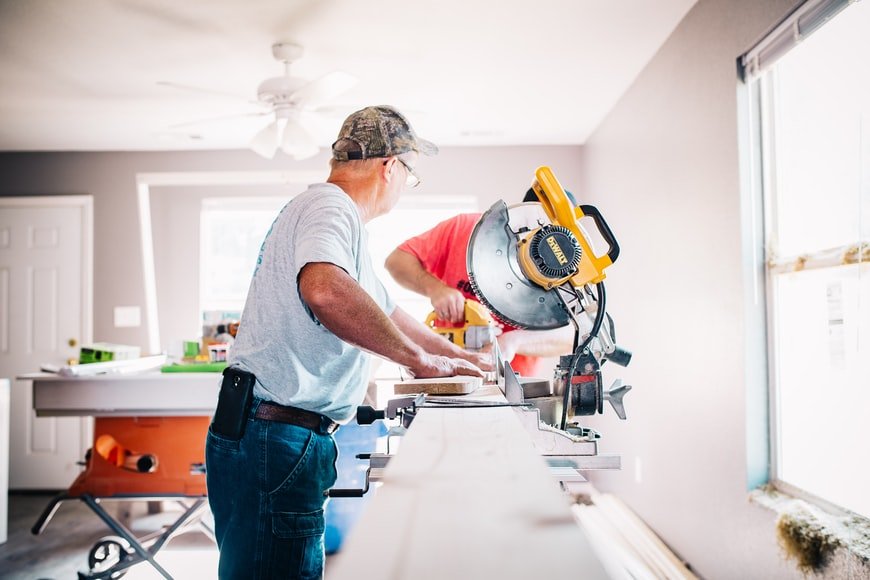If you’re a fan of home improvement shows, you witness a lot of incredible renovations. A contractor and designer go in and — poof! Someone ends up with the home of their dreams, totally unrecognizable from the original.
Maybe you recently bought a fixer-upper, or you’re thinking about one. It makes sense in a seller’s market when homes are going for a lot more than usual. But as you start taking down walls in your head, do you hear a “cha-ching” in your ears?
Unless you’re an accomplished DIYer, the thought of owning a fixer-upper can strike fear into your very soul. On the other hand, overspending on something move-in ready isn’t always the best choice. Spending less on a home with good bones and investing more to make it yours may be a savvy move.
If you’re a little freaked out about buying a fixer-upper, you’re not alone. But all you need is a little insight that might instill some confidence. Here are five ways to make home renovation feel feasible — and your decision more rewarding.
1. Get a Realistic Idea of Renovation Costs
Conventional wisdom says renovations will cost 20% more than you budgeted and take twice as long as you were told. It’s a good rule of thumb. Still, you can’t figure out a budget or timeline unless you know where to begin.
Start by researching realistic costs to do your project. Sources like Angi give you a general price range for projects plus an idea of costs in your market area. Angi also advises you on the variables that will make your costs lower or higher, like materials or finishes.
Get quotes from at least three contractors for time and materials to compare them. Understand that the lowest quote isn’t always the best one. Do a deep dive into those variables to make sure you’re comparing apples to apples.
Contractor quotes don’t cost you a dime. However, they will give you a credible sense of what certain things cost. Just add that 20% and you should know what to expect.
Consider Reading: 7 Cost-Saving Strategies for Your Home Renovation
2. Know Where You Can and Can’t Take Shortcuts
One of the secrets to sound home renovation is to know where and where not to take shortcuts. There’s a temptation to think you’ll use cheaper materials now and replace them later with something better. That strategy is OK with some things but inadvisable with others.
Take, for example, a kitchen renovation. You can change flooring and countertops fairly easily. You could use a roll vinyl flooring now to save some money (and broken dishes if you have young ones). In a few years, you could replace it with the tile you’ve always wanted with minimal fuss. It’s also not difficult to replace those Formica countertops with quartz or granite when you have the extra cash.
Cabinets are a different story. During the initial renovation, you should spend good money on getting great cabinets. The time, cost, and mess of replacing those a few years down the road aren’t worth taking a shortcut now.
If you can afford the entire reno all at once, do it and enjoy your dream kitchen right away. If you need to space out the investment, just do it wisely. Some shortcuts are fine, while others will end up forcing you to take the long route anyway.
3. Know What Flaws Are and Aren’t Major
There’s a reason that some houses are referred to as having “good bones” and others aren’t. In general, beware of the house with bad bones unless you’re willing to pretty much rebuild it.
“Bones” can refer to everything from foundation and structure to systems to layout to architectural details. As is true of the human body, some bones are just more important than others. A solid foundation in good repair, for instance, is far more vital than a cracked non-weight-bearing interior wall.
To bolster your confidence in buying a fixer-upper, pay for a detailed inspection that will expose major issues. Then talk to a contractor about the cost to make repairs. The more important the bone, the more it will cost to mend.
Applying fresh paint, changing out sliders for French doors, even replacing old windows are all reasonable and relatively easy fixes. In contrast, no amount of lipstick will compensate for the pig that is a buckling foundation wall or extensive termite damage. Those may cost you more than buying a move-in-ready property.
4. Learn How Things Work
Maybe you don’t know the business end of a screwdriver, or maybe you’re a whiz with a circular saw. The first step in overcoming your fear of fixer-uppers is to understand how things work. Basic knowledge of tools and construction may help put you at ease.
Fortunately, there are tons of opportunities to learn without investing a lot of money. There is at least one YouTube video that demonstrates how to use every tool imaginable. That includes those you’ve never even heard of, like a basin wrench or a biscuit joiner.
If you need more hands-on instruction, sign up for a class at a big-box home improvement store like Lowe’s or Home Depot. Better yet, volunteer for natural disaster rebuilding efforts or for a charitable homebuilding organization. Habitat for Humanity, for example, teaches volunteers basic skills before setting them loose.
Even if you’re leaving most of the home renovation work to someone else, it’s good to understand the basics. If nothing else, you’ll have an idea of how long it should be taking workers to get things done. Since labor comprises much of the cost of renovation, you’ll be all the wiser.
5. Know What to Leave to the Experts
Unless you happen to be a licensed electrician, the thought of doing that kind of work is probably frightening. Trust your instincts on that because there are some things you should leave to those who know what they’re doing.
That doesn’t mean you can’t do anything electrical. If you have some decent DIY skills, you might be able to replace an old ceiling fan. That’s after you flip off the breaker that powers it, of course.
You can probably also change out a faucet (and you’ll need that basin wrench for the job). But major plumbing, rewiring, and gas line, and HVAC work should be handled by those certified to do it. You will definitely sleep better knowing they did.
Even when you call in the pros, there are still many things you can do yourself to save a lot of money. Tackle projects like painting, affixing switch plates, and cleaning up every night instead of paying the contractor to do it. Not only will you get the job done, but you’ll also earn a feeling of can-do self-satisfaction.
If you have some amount of imagination, time, and budget, that fixer-upper may be the home of your dreams. Sure, you’ll have to look past the peeling paint, stained carpet, wonky stairs, and cracked concrete. But if you can face them without freaking out, you might just make the best investment of your life.
Read Also:






























